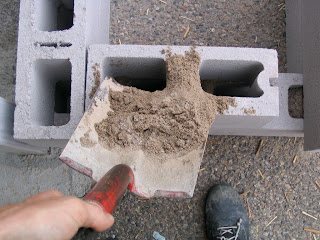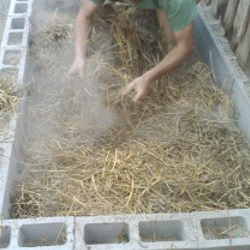Fall is the best time to plant many perennials, with once/month deep waterings through the winter, to foster deep and well-established root growth before spring comes along.
Following is a list of excellent edible perennials hardy to at least 15°F without special care, to at least 10°F with special care, and has some tolerance of or success in alkaline soils (Sources include the Native Plant Society of New Mexico and Joran Viers of the Bernalillo County Extension Office):
Almond (Prunus amygdalus)
Apple (Malus pumil)
Apricot; Golden Apple (Prunus armeniaca)
Artichoke, Globe (Cynara Scolymus)
Asparagus (Asparagus officinalis)
Autumn Olive (Elaeagnus umbellata)
Bay Laurel - (Laurus Nobilis; Umbellaria californica)
Blackberry (Rubus ulmifolius; R. ursinus) ...photo
Burnet (Poterium sanguisorba)
Cherry, Nanking; Downy C; Mountain C (Prunus tomentosa)
Cherry, Sour (Prunus cerasus)
Cherry, Sweet (Prunus avium)
Chives (Allium schoenoprasum; A. tuberosum) ...photo
Chokeberry, Black (Aronia melanocarpa)
Citrus, Hardy (various)
Cornelian Cherry; Cornel; Cornet Plum (Cornus mas)
Cranberry (Vaccinium macrocarpon)
Currant, Clove Black; Buffalo C. (Ribes odoratum; R. aureum)
Currant, European Black (Ribes nigrum)
Currant, Red; White C. (Ribes sativum; R. rubrum; R. petraeum)
Dandelion (Taraxacum officinale)
Elderberry, American; Sweet E. (Sambucus canadensis) ...photo
Fig (Ficus carica)
Filbert, European; Hazelnut (Corylus avellana) ...photo
Gooseberry (Ribes uva-crispa; R. hirtellum)
Grape, American (Vitis labrusca)
Grape, European; "The Vine" (Vitis vinifera)
Grape, Muscadine; Scuppernog (Vitis rotundifolia) ...photo
Gumi; Cherry Elaeagnus (Elaeagnus multiflora)
Hickory (Carya ovata; C. laciniosa)
Hyssop (Hyssopus officinalis)
Jostaberry (Ribes nidigrolaria) ...photo
Jujube; Chinese Date (Ziziphus jujuba) ...photo
Kiwi, Arctic Beauty (Actinidia kolomitka)
Kiwi, Hardy (Actinidia arguta) ...photo
Kiwi; Yang Tao; Chinese Gooseberry (Actinidia deliciosa)
Lemon Balm (Melissa officinalis)
Lingonberry; Cowberry (Vaccinium vitis-idaea)
Loquat (Eriobotrya japonica)
Lovage (Levisticum officinale)
Medlar (Mespilus germanica) ...photo
Mint; Spearmint (Mentha spicata)
Mulberry, Black (Morus nigra)
Onion, Tree; Egyptian O.; Catawissa (Allium cepa aggregatum) ...photo
Oregano; Wild Marjoram (Origanum vulgare)
Passionfruit; Maypop (Passiflora incarnata)
Pawpaw; Michigan banana (Asimina triloba )
Peach; Nectarine (Prunus persica)
Pear, Asian; Sand Pear; Apple Pear (Pyrus pyrifolia)
Pear, European (Pyrus communis)
Pecan (Carya illinoensis) ...photo
Persimmon, American (Diospyros virginiana)
Persimmon, Oriental; Kaki (Diospyros kaki)
Pineapple Guava; Feijoa (Feijoa sellowiana) ...photo
Pistachio (Pistacia vera)
Plum, European; Prune (Prunus domestica)
Plum, Japanese (Prunus salicina)
Pomegranate (Punica granatum)
Quince (Cydonia oblonga)
Raisin Tree (Hovenia dulcis)
Raspberry (Rubus idaeus; R. occidentalis)
Rhubarb (Rheum rhaponticum)
Rose Hips; Rugosa Rose (Rosa rugosa; R. eglanteria)
Rosemary (Rosmarinus officinale) ...photo
Russian Olive; Oleaster (Elaeagnus angustifolia)
Sage (Salvia officinalis)
Saskatoon; Serviceberry; Juneberry (Amelanchier alnifolia)
Savory, Winter (Satureja montana)
Sea Buckthorn; Sea Berry (Hippophae rhamnoides)
Sorrel; English Sorrel; Sour Dock (Rumex acetosa)
Strawberry (Fragaria X Ananassa )
Strawberry, Alpine; Fraise de Bois (Fragaria vesca) ...photo
Strawberry, Musk; Hautbois (Fragaria moschata) ...photo
Tarragon, French (Artemisia dracunculus)
Thyme; Lemon Thyme (Thymus vulgaris; T. citriodorus)
Walnut, Black (Juglans nigra)
Walnut, Persian; English Walnut (Juglans regia)
Consider cultivating a habitat garden and reduce your hoe load: weed less and water less with a balanced landscape. Take your plant understanding a step further and become familiarized with a beneficial weeds! While many insects and wildlife can be troublesome, some are beneficial and can be attracted or supported using the following plants.
Pest-repellant
Neem -- repels leaf eating insects
Edible
Cornflower various colours; can be served as edible garnish to decorate salads.
Painter's brush weed
Chickweed -- used in salads and also as ground cover
Burdock -- roots are edible
Horsetail -- prehistoric plant that produces its own vitamin D & is high in silica; tops are very similar to & may be eaten like asparagus
Lamb's quarters -- leaves and shoots, raw, also prevents erosion, also distracts leaf miners from nearby crops
Purslane -- prepared raw for salads or sautéed
Shepherd's purse -- leaves are edible and often sautéed or blanched
Watercress -- can be eaten raw or cooked; is considered a weed in some cultures
Habitat for beneficial insects
Wild blackberry -- attracts predatory insects, and produces berries
Motherwort -- attracts bees
Joe-Pye weed -- habitat for pollinators and predatory insects
Aster -- habitat predatory insects
Trap crops
Trap crops draw potential pests away from the actual crop intended for cultivation.
Cowpea -- attracts ladybird beetle, so planting around cotton fields protects them from sucking insects. It serve as source of food and niche.
Just start somewhere and come back to this when you want more info!




















